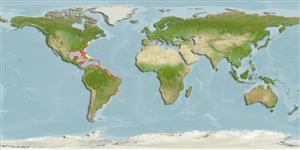Environment: milieu / climate zone / depth range / distribution range
Ecologia
marino associati a barriera corallina; distribuzione batimetrica 1 - 50 m (Ref. 93252), usually 5 - ? m (Ref. 9710). Tropical; 41°N - 37°S, 98°W - 33°W (Ref. 188)
Western Atlantic: Gulf of Maine (USA), Bermuda, throughout the Gulf of Mexico, Caribbean and West Indies southward to Santa Catarina, Brazil. Also found in Uruguay (Ref. 54736) and Argentina (Ref. 2806).
Length at first maturity / Size / Peso / Age
Maturity: Lm 11.5, range 11 - ? cm
Max length : 38.0 cm TL maschio/sesso non determinato; (Ref. 5217); common length : 20.0 cm SL maschio/sesso non determinato; (Ref. 188); peso massimo pubblicato: 375.00 g (Ref. 5217)
Spine dorsali (totale): 0; Raggi dorsali molli (totale): 19-21; Spine anali 0; Raggi anali molli: 23 - 24. The filamentous last dorsal fin ray distinguishes this species from all other western Atlantic clupeoids except Dorosoma, which has an inferior mouth (Ref. 188). Otherwise, superficially resembles species of Sardinella (but i 8 pelvic fin rays in western Atlantic species, cf. i 7 in Opisthonema) and Harengula (but small toothed hypomaxilla in upper jaw) (Ref. 188). Lower gill rakers stable at 28 to 46 after 8 cm (Ref. 188). Silvery, with a bluish or greenish back, 6-7 lengthwise dark streaks on side. Dark spot above opercle, larger dark spot behind opercle, usually with a row of dark spots behind it. Lower profile deeply curved. Head pointed (Ref. 7251).
Inhabit harbors and shallow coastal areas (Ref. 9710). Pelagic (Ref. 27549). Form schools (but solitary individuals reported), probably not entering water of low salinity. Feed by filtering plankton (copepods), but also take small fishes, crabs and shrimps. Marketed fresh, frozen and salted; also used in the fishmeal industry. Occur in freshwater in St. Johns River, Florida (Ref. 26938).
Possibly breeds in March-July off Venezuela.
Whitehead, P.J.P., 1985. FAO Species Catalogue. Vol. 7. Clupeoid fishes of the world (suborder Clupeoidei). An annotated and illustrated catalogue of the herrings, sardines, pilchards, sprats, shads, anchovies and wolf-herrings. FAO Fish. Synop. 125(7/1):1-303. Rome: FAO. (Ref. 188)
IUCN Red List Status (Ref. 130435)
Threat to humans
Reports of ciguatera poisoning (Ref. 30911)
Human uses
Pesca: commerciale; esca: usually
Strumenti
Special reports
Download XML
Fonti Internet
Estimates based on models
Preferred temperature (Ref.
123201): 22.7 - 28, mean 25.5 °C (based on 480 cells).
Phylogenetic diversity index (Ref.
82804): PD
50 = 0.5312 [Uniqueness, from 0.5 = low to 2.0 = high].
Bayesian length-weight: a=0.00851 (0.00745 - 0.00972), b=3.03 (2.99 - 3.07), in cm total length, based on LWR estimates for this species (Ref.
93245).
Trophic level (Ref.
69278): 4.5 ±0.0 se; based on diet studies.
Resilienza (Ref.
120179): Medio, tempo minimo di raddoppiamento della popolazione 1.4 - 4.4 anni (tm=1-3; tmax=8).
Prior r = 1.18, 95% CL = 0.78 - 1.77, Based on 4 stock assessments.
Fishing Vulnerability (Ref.
59153): Low vulnerability (24 of 100).
Climate Vulnerability (Ref.
125649): Moderate to high vulnerability (54 of 100).
Nutrients (Ref.
124155): Calcium = 59.1 [28.2, 107.6] mg/100g; Iron = 0.805 [0.394, 1.446] mg/100g; Protein = 19.9 [18.5, 21.2] %; Omega3 = 0.242 [0.132, 0.455] g/100g; Selenium = 34.8 [18.7, 79.4] μg/100g; VitaminA = 95.7 [28.7, 303.9] μg/100g; Zinc = 0.856 [0.565, 1.280] mg/100g (wet weight);
